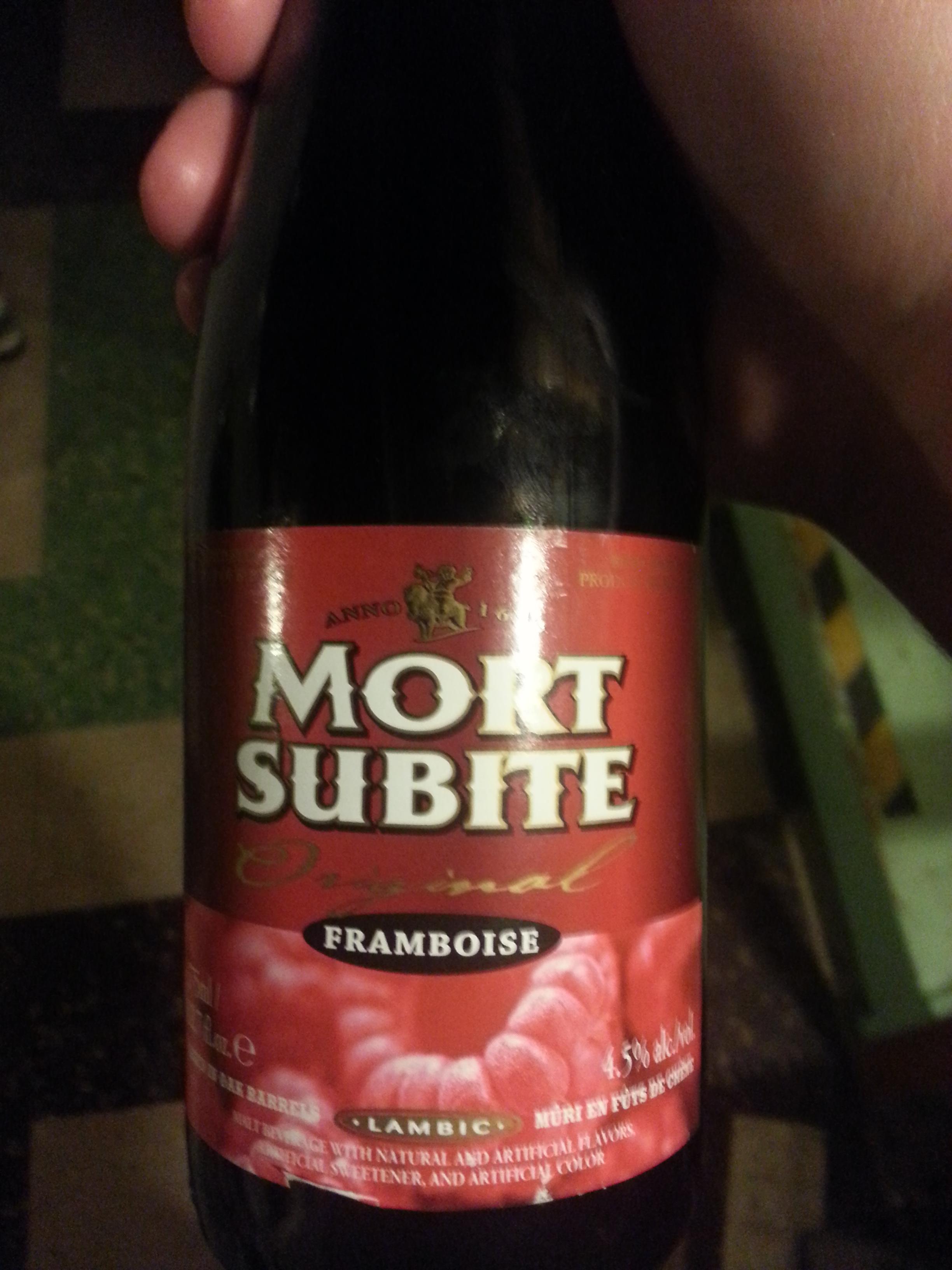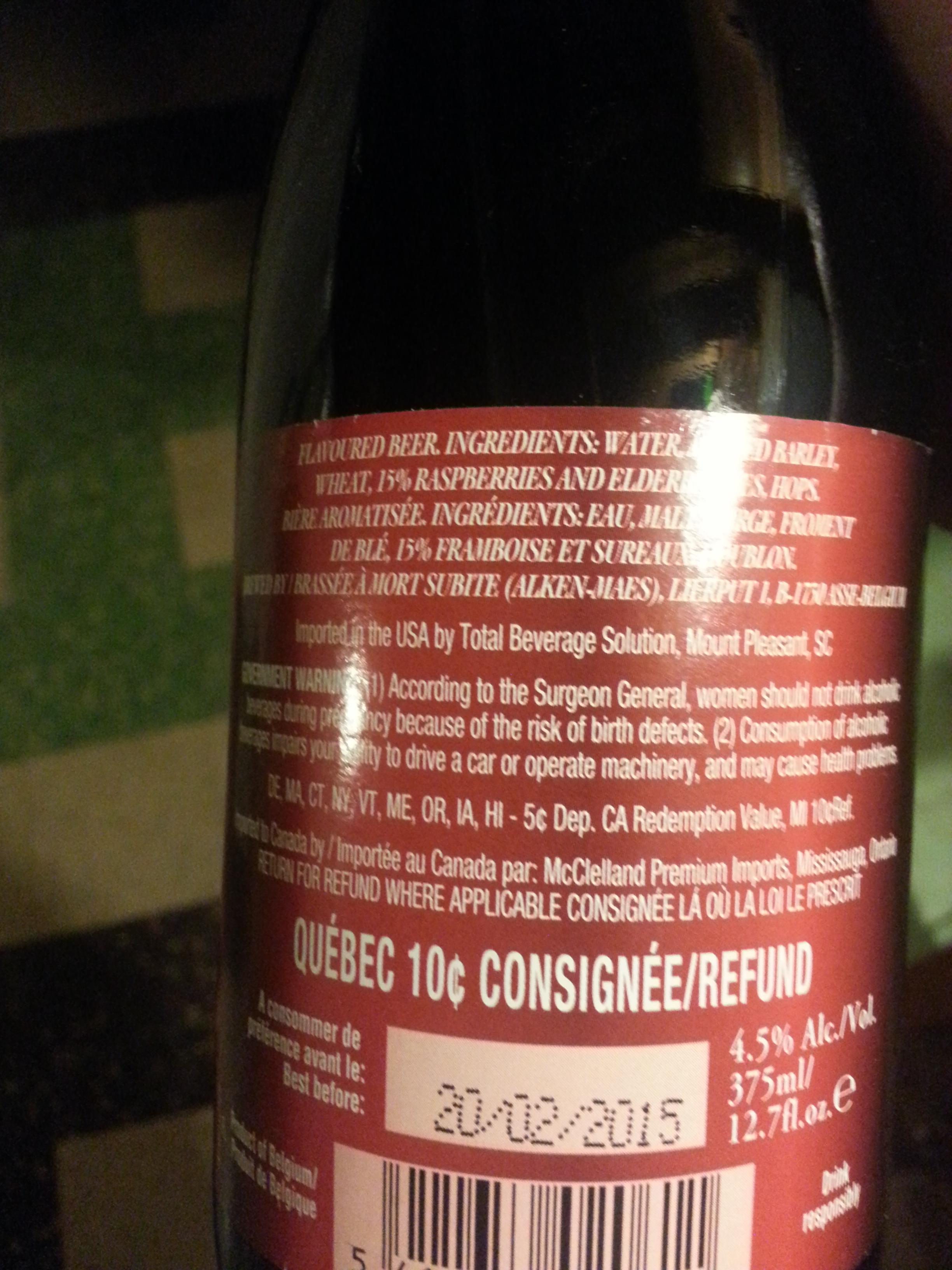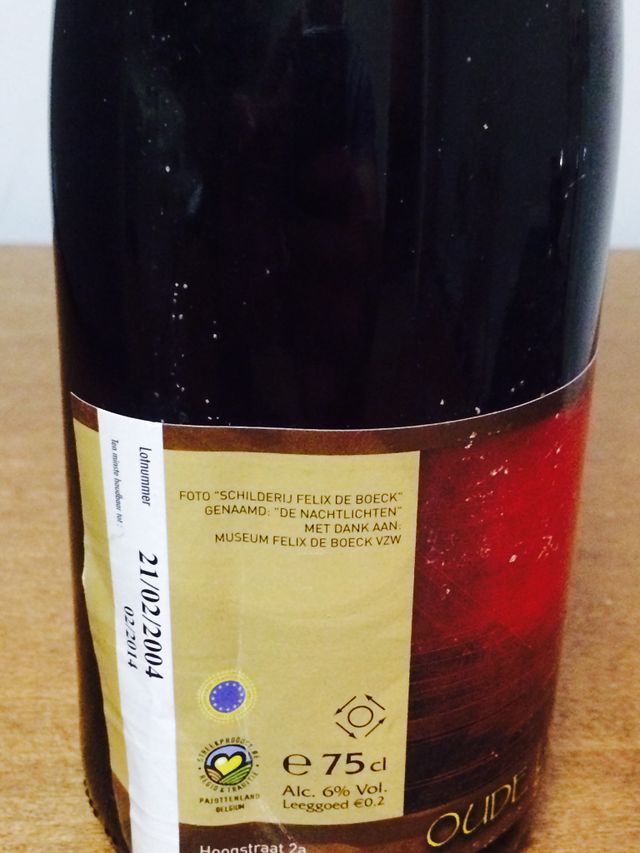sacrelicio
Well-Known Member
Isn't that a pretty common beer in the US?I know its likely not very important on the beer geek list but just for information completeness Mort Subite framboise and Kriek can be found in the US and not just Canada.



Isn't that a pretty common beer in the US?I know its likely not very important on the beer geek list but just for information completeness Mort Subite framboise and Kriek can be found in the US and not just Canada.



No idea. I don't see it in Buffalo but grabbed a bottle in Rochester a while back.Isn't that a pretty common beer in the US?
I have access to a 98 3F OG. If I can add anything, feel free to give me a shout! Happy to contribute pictures, any info, or send bottles/glasses/other stuff for science!There won't be, at least not based on current information. As the Lambic.Info project has shown me time and time again, the history and knowledge around vintage lambics is vague, often nothing more than rumor.
There was an update issued to that article (http://allaboutbeer.com/article/ghost-whales/). After it was initially published, a direct source came forward. This is the risk of chasing rare old lambic, but also one of the many benefits to a project like this to help clear up these rumors. It appears that the bottle was a custom labeled 3F gueuze to celebrate the birth of a local lambic fan's twins. There are actually two versions, a gueuze for the boy and a kriek for the girl. But, the point is that it's not a unique lambic based on that. It was misinformation.
I do still have some questions about that though, as 1998 3F Gueuze was cork and caged, but the Driesjes Eerste Plasje was cork and crowned. Also, I've had late 1990's 3F Gueuze multiple times, it this tasted very different. But the updated information was sourced directly and we have no other info to the contrary at the moment to assume it's anything other then a home-labeling.
"The purpose of this article is to explore the historical, etymological, linguistic, and orthographic differences found among lambic terminology, labeling, and appellation."

#nerdalert
is it agreed that all spontaneous beers outside of Belgium are now "American"? Because we are stuck with American pale ale, even for beers made entirely with NZ or Australian ingredients (this is slowly changing but for the most part they are still referred to as APAs)
Do we have to be stuck with it for another thing? In this case it makes even less sense as brewers do look to the US for pale ale influence but Belgian is still where everyone is looking for sour influence (despite the excellent sours/wild beers out of the states of course).
Definitely not. The use of the term is intended to be a specific example of non-lambic spontaneous fermentation in beer, and that's what it's called in the literature. Given how broad of a style "American Wild Ales" is, if it can even be called that, I see no reason to give all sour beers that don't fall neatly into one of the other buckets that name. At least with APAs it's a clear style that was developed in the US. With AWAs, at least to me, it feels like it's not a clear style but rather a catch-all for anything that doesn't fit into some other, more specific style.
Agreed. I don't think there's any reason why we need to be stuck with this initialism, but I needed a name for the other spontaneously fermented beer that was being compared and contrasted to lambic in that section, and American Coolship Ale is what the literature uses. I kept "American Wild Ale" there as well, as that's what most readers would probably recognize them as, though that name is applied to all kinds of stuff that doesn't spend time in the big shallow pan.
No way, I spend my time talking about beers on an Internet message board because I'm super... whatever the opposite of nerdy is
Also, just read the AWA/ACA on the microorganisms page.
is it agreed that all spontaneous beers outside of Belgium are now "American"? Because we are stuck with American pale ale, even for beers made entirely with NZ or Australian ingredients (this is slowly changing but for the most part they are still referred to as APAs)
Do we have to be stuck with it for another thing? In this case it makes even less sense as brewers do look to the US for pale ale influence but Belgian is still where everyone is looking for sour influence (despite the excellent sours/wild beers out of the states of course).
What I'm saying is, quit hogging the initialisms.
Definitely not. The use of the term is intended to be a specific example of non-lambic spontaneous fermentation in beer, and that's what it's called in the literature. Given how broad of a style "American Wild Ales" is, if it can even be called that, I see no reason to give all sour beers that don't fall neatly into one of the other buckets that name. At least with APAs it's a clear style that was developed in the US. With AWAs, at least to me, it feels like it's not a clear style but rather a catch-all for anything that doesn't fit into some other, more specific style.
Agreed. I don't think there's any reason why we need to be stuck with this initialism, but I needed a name for the other spontaneously fermented beer that was being compared and contrasted to lambic in that section, and American Coolship Ale is what the literature uses. I kept "American Wild Ale" there as well, as that's what most readers would probably recognize them as, though that name is applied to all kinds of stuff that doesn't spend time in the big shallow pan.
It's a tough one because the people driving taxonomy are mostly coming from the US. Here in Aus. people are still happy to call them lambics and sours (even if they are straight brett). So inevitably we end up with "American" as the differentiating term. There are maybe... 3 or 4 breweries here in Australia experimenting with true spontaneous fermentation and they are still in their infancy; so there isn't a great rush to classify them from the wider public. As far as I know, no-one in New Zealand is (am asking around now for my own interest).
Whether or not new classifications or terms rise organically remains to be seen I guess. I just don't want to be stuck saying to people in Australia "it's not a lambic, it's an AWA..." (which admittedly I'm not and shouldn't ever be as I'm probably in just as good of a position to drive the taxonomy here as anyone, other than the brewers slapping "lambic" on anything soured).
Personally, I believe "sour ale" should imply it's from a culture, while "wild ale" implies spontaneous fermentation.
I'm just thinking out loud more than anything though.
My issue with "sour ale" (as an Untappd moderator, at least) is that it's not obvious that it's a specific category. So naifs will put literally anything that's sour in as that, even if it would be better as some other style (Flemish Red, for instance). I also tend to think that people are way too literal about the country thing, clearly you can make a Belgian Pale Ale (or whatever) in other countries, it's not an actual appellation.It's a tough one because the people driving taxonomy are mostly coming from the US. Here in Aus. people are still happy to call them lambics and sours (even if they are straight brett). So inevitably we end up with "American" as the differentiating term. There are maybe... 3 or 4 breweries here in Australia experimenting with true spontaneous fermentation and they are still in their infancy; so there isn't a great rush to classify them from the wider public. As far as I know, no-one in New Zealand is (am asking around now for my own interest).
Whether or not new classifications or terms rise organically remains to be seen I guess. I just don't want to be stuck saying to people in Australia "it's not a lambic, it's an AWA..." (which admittedly I'm not and shouldn't ever be as I'm probably in just as good of a position to drive the taxonomy here as anyone, other than the brewers slapping "lambic" on anything soured).
Personally, I believe "sour ale" should imply it's from a culture, while "wild ale" implies spontaneous fermentation.
I'm just thinking out loud more than anything though.
My issue with "sour ale" (as an Untappd moderator, at least) is that it's not obvious that it's a specific category. So naifs will put literally anything that's sour in as that, even if it would be better as some other style (Flemish Red, for instance). I also tend to think that people are way too literal about the country thing, clearly you can make a Belgian Pale Ale (or whatever) in other countries, it's not an actual appellation.
Having a distinction between Wild Ale (a sort of "none of the above" for beers that contain non-sacc yeasts) and Coolship Ale seems fine to me, but I'd really be annoyed if "Sour Ale" became a thing. No one calls Barleywines/Stouts "Sweet Ales".
My issue with "sour ale" (as an Untappd moderator, at least) is that it's not obvious that it's a specific category. So naifs will put literally anything that's sour in as that, even if it would be better as some other style (Flemish Red, for instance). I also tend to think that people are way too literal about the country thing, clearly you can make a Belgian Pale Ale (or whatever) in other countries, it's not an actual appellation.
Having a distinction between Wild Ale (a sort of "none of the above" for beers that contain non-sacc yeasts) and Coolship Ale seems fine to me, but I'd really be annoyed if "Sour Ale" became a thing. No one calls Barleywines/Stouts "Sweet Ales".
Maybe I'm late to this party, and I'm definitely out of my depth.
What is wrong with a large grouping called "mixed fermentation ales"? They could then be broken into smaller groupings based on ingredients, geography, or arbitrary reasons.
This whole lambic thing is sort of a champagne/prosecco/sparkling white wine thing, IMO. I always thought it was strange to differentiate what is more or less the same beverage based on where it was made. That being said, I'm looking forward to educating myself on the new site. Nice work.
I kinda like "mixed fermentation ale", though that's a very broad category. That said, I think that's probably what's needed, so that any beer that uses mixed fermentation but doesn't fall into one of the more specific styles will be caught by it.
LukeAleTime: I've added some new language to that section of the microbio page that describes the current problem with the name "AWAs" a bit. Let me know if it's better!
That's always been my understanding. They bottled it on 2/14/2007 so they put that slightly different label on it.I was looking at the info on 3F VOG too find some info in the 2007 Vantentijin label. I didn't see much other than that it's a variable label. is the label just because of St Valentine's Day? Nothing more?
Cheers
I was looking at the info on 3F VOG too find some info in the 2007 Vantentijin label. I didn't see much other than that it's a variable label. is the label just because of St Valentine's Day? Nothing more?
Cheers

I'll be opening one in a few weeks at a tasting and I'll report back about the taste and the cork.
I'll be opening one in a few weeks at a tasting and I'll report back about the taste and the cork.
I was looking at the info on 3F VOG too find some info in the 2007 Vantentijin label. I didn't see much other than that it's a variable label. is the label just because of St Valentine's Day? Nothing more?
Cheers
That's always been my understanding. They bottled it on 2/14/2007 so they put that slightly different label on it.
Isn't there a 750ml bottling of OGV from Feb 2004 with Nighlights label? Don't see that one listed but I may be wrong.
Isn't there a 750ml bottling of OGV from Feb 2004 with Nighlights label? Don't see that one listed but I may be wrong.
Link?
I'm at the zoo and looking mobileHow could you have possibly missed it on the homepage? We're running a banner across the top right now!
Nice to know i'm not the only one who goes to the zoo to read Talkbeer and Lambic.InfoI'm at the zoo and looking mobile
I'm at the zoo and looking mobile
Nice to know i'm not the only one who goes to the zoo to read Talkbeer and Lambic.Info

It guaranteed that any sweetened geuze would simply be called ‘geuze’ and any fully traditionally produced geuze would be called ‘oude geuze’, with the adjective ‘oude’ as a title that guarantees that the beer has been prepared the old, traditional way.
Additionally, this KB ignored the reality that there are two totally different productten, real Geuze and capsulekesgeuze, continued to bear the same name (see photo). Any subsequent adjustments, in 1973, 1974 and 1993, up to this reality beyond.
Question about TSG as mentioned on the Sweetened Lambic page
Is there an updated TSG document to this one that discusses the sweetened geuze/oude geuze difference?
http://eur-lex.europa.eu/LexUriServ/LexUriServ.do?uri=OJ:C:1997:021:0013:0014:EN:PDF
I found the citation for the paragraph on google books, but the references page isn't available.
Link: http://goo.gl/qUqptu
- Tessa Avermaete and Gert Vandermosten, Traditional Belgian Beers in a Global Market Economy, 2009
The HORAL page isn't clear when put through translate:
Capsulekesgeuze? Is that sweetened geuze? (couldn't find a mention of it on the site, and google only brings up three other sites mentioning that word; but the internet can't give me an english translation).
Enter your email address to join: